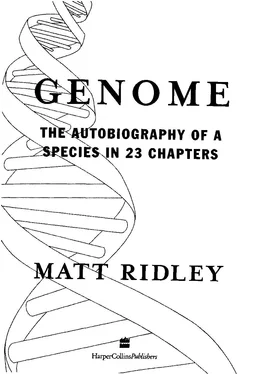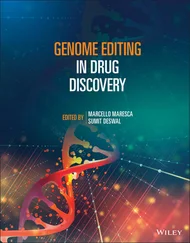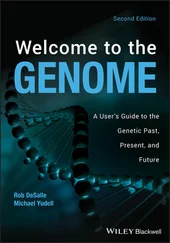Genome - Matt Ridley
Здесь есть возможность читать онлайн «Genome - Matt Ridley» — ознакомительный отрывок электронной книги совершенно бесплатно, а после прочтения отрывка купить полную версию. В некоторых случаях можно слушать аудио, скачать через торрент в формате fb2 и присутствует краткое содержание. Жанр: Старинная литература, на английском языке. Описание произведения, (предисловие) а так же отзывы посетителей доступны на портале библиотеки ЛибКат.
- Название:Matt Ridley
- Автор:
- Жанр:
- Год:неизвестен
- ISBN:нет данных
- Рейтинг книги:5 / 5. Голосов: 1
-
Избранное:Добавить в избранное
- Отзывы:
-
Ваша оценка:
- 100
- 1
- 2
- 3
- 4
- 5
Matt Ridley: краткое содержание, описание и аннотация
Предлагаем к чтению аннотацию, описание, краткое содержание или предисловие (зависит от того, что написал сам автор книги «Matt Ridley»). Если вы не нашли необходимую информацию о книге — напишите в комментариях, мы постараемся отыскать её.
Matt Ridley — читать онлайн ознакомительный отрывок
Ниже представлен текст книги, разбитый по страницам. Система сохранения места последней прочитанной страницы, позволяет с удобством читать онлайн бесплатно книгу «Matt Ridley», без необходимости каждый раз заново искать на чём Вы остановились. Поставьте закладку, и сможете в любой момент перейти на страницу, на которой закончили чтение.
Интервал:
Закладка:
The SRY gene is peculiar. Its sequence is remarkably consistent between different men: there are virtually no point mutations (i.e., one-letter spelling differences) in the human race. SRY is, in that sense, a variation-free gene that has changed almost not at all since the last common ancestor of all people 200,000 years ago or so. Yet our SRY is very different from that of a chimpanzee, and different again from that of a gorilla: there is, between species, ten times as much variation in this gene as is typical for other genes. Compared with other active (i.e., expressed) genes, SRY is one of the fastest evolving.
How do we explain this paradox? According to William Amos and John Harwood, the answer lies in the process of fleeing and hiding that they call selective sweeps. From time to time, a driving gene appears on the X chromosome that attacks the Y chromosome by recognising the protein made by SRY. At once there is a selective advantage for any rare SRY mutant that is sufficiently different to be unrecognised. This mutant begins to spread at the expense of other males. The driving X chromosome distorts the sex ratio in favour of females but the spread of the new mutant SRY restores the balance. The end result is a brand new SRY gene sequence shared by all members of the species, with little variation. The effect of this sudden burst of evolution (which might happen so quickly as to leave few traces in the evolutionary record) would be to produce SRYs that were very different between species, but very similar within species. If Amos and Harwood are right, at least one such sweep must have occurred since the splitting of chimp ancestors and human ancestors, five to ten million years ago, but before the ancestor common to all modern human beings, 200,000 years ago.6
You may be feeling a little disappointed. The violence and conflict C O N F L I C T 1 1 3
that I promised at the beginning of the chapter turn out to be little more than a detailed piece of molecular evolution. Fear not. I am not finished yet, and I plan to link these molecules to real, human conflict soon enough.
The leading scholar of sexual antagonism is William Rice of the University of California at Santa Cruz and he has completed a remarkable series of experiments to make the point explicit. Let us go back to our putative ancestral creature that has just acquired a distinct Y chromosome and is in the process of shutting down many of the genes on it to escape driving X genes. This nascent Y
chromosome, in Rice's phrase, is now a hotspot for male-benefit genes. Because a Y chromosome will never find itself in a female, it is free to acquire genes that are very bad for females so long as they are at least slightly good for males (if you still thought evolution was about the good of the species, stop thinking so right now). In fruit flies, and for that matter in human beings, male ejaculate consists of sperm cells suspended in a rich soup called the seminal fluid.
Seminal fluid contains proteins, products of genes. Their purpose is entirely unknown, but Rice has a shrewd idea. During fruit-fly sex, those proteins enter the bloodstream of the female and migrate to, among other places, her brain. There they have the effect of reducing the female's sexual appetite and increasing her ovulation rate. Thirty years ago, we would have explained that increase in terms of the good of the species. It is time for the female to stop seeking sexual partners and instead seek a nesting site. The male's seminal fluid redirects her behaviour to that end. You can hear the National Geographic commentary. Nowadays, this information takes on a more sinister aura. The male is trying to manipulate the female into mating with no other males and into laying more eggs for his sperm and he is doing so at the behest of sexually antagonistic genes, probably on the Y chromosome (or switched on by genes on the Y chromosome). The female is under selective pressure to be more and more resistant to such manipulation. The outcome is a stalemate.
Rice did an ingenious experiment to test his idea. For twenty-nine 1 1 4 G E N O M E
generations, he prevented female flies from evolving resistance: he kept a separate strain of females in which no evolutionary change occurred. Meanwhile, he allowed males to generate more and more effective seminal fluid proteins by testing them against more and more resistant females. After twenty-nine generations he brought the two lines together again. The result was a walkover. Male sperm was now so effective at manipulating female behaviour that it was effectively toxic: it could kill the females.7
Rice now believes that sexual antagonism is at work in all sorts of environments. It leaves its signature as rapidly evolving genes. In the shellfish the abalone, for instance, the lysin protein that the sperm uses to bore a hole through the glycoprotein matrix of the egg is encoded by a gene that changes very rapidly (the same is probably true in us), probably because there is an arms race between the lysin and the matrix. Rapid penetration is good for sperm but bad for the egg, because it allows parasites or second sperm through.
Coming slightly closer to home, the placenta is controlled by rapidly evolving genes (and paternal ones, at that). Modern evolutionary theorists, led by David Haig, now think of the placenta as more like a parasitic takeover of the mother's body by paternal genes in the foetus. The placenta tries, against maternal resistance, to control her blood-sugar levels and blood pressure to the benefit of the foetus.8
More on this in the chapter on chromosome 15.
But what about courtship behaviour? The traditional view of the peacock's elaborate tail is that it is a device designed to seduce females and that it is in effect designed by ancestral females' preferences. Rice's colleague, Brett Holland, has a different explanation.
He thinks peacocks did indeed evolve long tails to seduce females, but that they did so because females grew more and more resistant to being so seduced. Males in effect use courtship displays as a substitute for physical coercion and females use discrimination to retain control over their own frequency and timing of mating. This explains a startling result from two species of wolf spiders. One species has tufts of bristles on its forelegs that it uses in courtship.
Shown a video of a male spider displaying, the female will indicate C O N F L I C T 1 1 5
by her behaviour whether the display turns her on. If the videos are altered so that the males' tufts disappear, the female is still just as likely to find the display arousing. But in another species, where there are no tufts, the artificial addition of tufts to males on the video more than doubled the acceptance rate of females. In other words, females gradually evolve so that they are turned off, not on, by the displays of males of their own species. Sexual selection is thus an expression of sexual antagonism between genes for seduction and genes for resistance.9
Rice and Holland come to the disturbing conclusion that the more social and communicative a species is, the more likely it is to suffer from sexually antagonistic genes, because communication between the sexes provides the medium in which sexually antagonistic genes thrive. The most social and communicative species on the planet is humankind. Suddenly it begins to make sense why relations between the human sexes are such a minefield, and why men have such vastly different interpretations of what constitutes sexual harassment from women. Sexual relations are driven not by what is good, in evolutionary terms, for men or for women, but for their chromosomes. The ability to seduce a woman was good for Y chromosomes in the past; the ability to resist seduction by a man was good for X chromosomes in the past.
Читать дальшеИнтервал:
Закладка:
Похожие книги на «Matt Ridley»
Представляем Вашему вниманию похожие книги на «Matt Ridley» списком для выбора. Мы отобрали схожую по названию и смыслу литературу в надежде предоставить читателям больше вариантов отыскать новые, интересные, ещё непрочитанные произведения.
Обсуждение, отзывы о книге «Matt Ridley» и просто собственные мнения читателей. Оставьте ваши комментарии, напишите, что Вы думаете о произведении, его смысле или главных героях. Укажите что конкретно понравилось, а что нет, и почему Вы так считаете.












